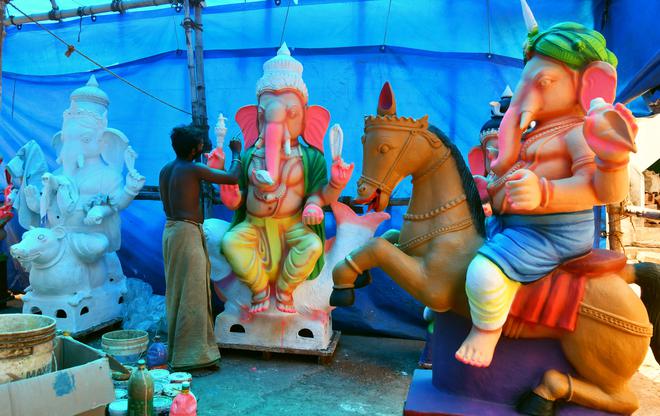In the bylanes of Vilachery, in Madurai district, there is a palpable buzz of frenzied energy that of artisans busy at their work. With just a week to go for Ganesh Chathurthi, in almost all the houses, the women folk are bent over little Ganeshas, some busy pressing the mud in prefabricated wooden moulds to get the desired shape, while some are busy giving a varnish and coat of water soluble paint to the idols.
In some nooks, big size Ganeshas are being prepared and this year, the tallest that is being made here is an eight-feet idol, which is getting its final coat of paint.
M. Ramalingam, senior artisan, said that this year the business has been good. Though prices have increased from last year, the sales have also improved. This year about 10 tonnes of plaster of paris has been sourced from Thoothukudi, where there are a large number of gypsum companies. Last year, the price of one tonne of plaster of paris was ₹10,000 and this year it has gone up to ₹13,000. Similarly transport charges have also increased, he said.
Paper dust, which is needed for making paper mache idols, is sourced from industries generating this waste in Kappalur. Even this cost has increased, said Mr. Ramalingam. Last year 10 kg of this dust was being sold at ₹100 and this year it’s ₹120. There has been a 20% increase in all the prices, he added.
About 150 families in Vilachery are directly involved in doll making, while 100 families are indirectly involved in this industry. After COVID, salaries for these workers have also increased. “Some of the skilled craftsmen are even paid more than ₹1000 as daily wages and some even work on commission basis”, he added.

In one of the sheds, Vijayakumar is busy sculpting a mud Vinayagar, while in a corner a couple of boys are trampling mud mixed with sand and elephant dung. “This will give the mud sourced from the Thiruparankundram tank, the right malleability to make the idols,” he said. “For these huge mud idols, orders were given and an advance paid on the 18th day of the Tamil month of Aadi. For every 1 feet, we charge ₹3000”, he added.
“Whereas making of the little vinayagars begins from April. As retail traders give us orders in hundreds our work begins much earlier”, said Alagarsamy, another artisan. A three inch vinayagar was sold for ₹40 last year and this year it’s ₹50. “Though, the cost of materials has increased including that of paints, the water-soluble paints that have come into the market has in a way made our work easier as it dries faster and gives a more glossy finish,” he added.
“Earlier on, we used to paint with red oxide sourced from West Bengal. But now even there this natural pigment used for colouring has become rare. Today, as people ask for Ganeshas in fluorescent colours and with gold painted filigree work, we have the right materials to give them, what they want”, said Mr. Ramalingam.







